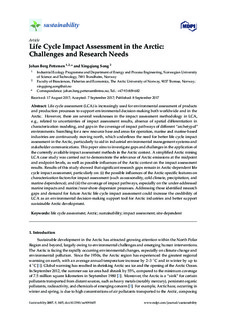| dc.contributor.author | Pettersen, Johan Berg | |
| dc.contributor.author | Song, Xingqiang | |
| dc.date.accessioned | 2017-12-20T08:40:17Z | |
| dc.date.available | 2017-12-20T08:40:17Z | |
| dc.date.created | 2017-11-14T15:01:48Z | |
| dc.date.issued | 2017 | |
| dc.identifier.citation | Sustainability. 2017, 9 (9), . | nb_NO |
| dc.identifier.issn | 2071-1050 | |
| dc.identifier.uri | http://hdl.handle.net/11250/2473151 | |
| dc.description.abstract | Life cycle assessment (LCA) is increasingly used for environmental assessment of products and production processes to support environmental decision-making both worldwide and in the Arctic. However, there are several weaknesses in the impact assessment methodology in LCA, e.g., related to uncertainties of impact assessment results, absence of spatial differentiation in characterization modeling, and gaps in the coverage of impact pathways of different “archetypal” environments. Searching for a new resource base and areas for operation, marine and marine-based industries are continuously moving north, which underlines the need for better life cycle impact assessment in the Arctic, particularly to aid in industrial environmental management systems and stakeholder communications. This paper aims to investigate gaps and challenges in the application of the currently available impact assessment methods in the Arctic context. A simplified Arctic mining LCA case study was carried out to demonstrate the relevance of Arctic emissions at the midpoint and endpoint levels, as well as possible influences of the Arctic context on the impact assessment results. Results of this study showed that significant research gaps remain in Arctic-dependent life cycle impact assessment, particularly on: (i) the possible influences of the Arctic-specific features on characterization factors for impact assessment (such as seasonality, cold climate, precipitation, and marine dependence); and (ii) the coverage of impact pathways, especially on the under-addressed marine impacts and marine/near-shore dispersion processes. Addressing those identified research gaps and demand for future Arctic life cycle impact assessment could increase the credibility of LCA as an environmental decision-making support tool for Arctic industries and better support sustainable Arctic development | nb_NO |
| dc.language.iso | eng | nb_NO |
| dc.publisher | MDPI | nb_NO |
| dc.rights | Navngivelse 4.0 Internasjonal | * |
| dc.rights.uri | http://creativecommons.org/licenses/by/4.0/deed.no | * |
| dc.title | Life cycle impact assessment in the arctic: Challenges and research needs | nb_NO |
| dc.type | Journal article | nb_NO |
| dc.type | Peer reviewed | nb_NO |
| dc.description.version | publishedVersion | nb_NO |
| dc.source.pagenumber | 20 | nb_NO |
| dc.source.volume | 9 | nb_NO |
| dc.source.journal | Sustainability | nb_NO |
| dc.source.issue | 9 | nb_NO |
| dc.identifier.doi | 10.3390/su9091605 | |
| dc.identifier.cristin | 1514067 | |
| dc.relation.project | Norges forskningsråd: 195160 | nb_NO |
| dc.description.localcode | This is an open access article distributed under the Creative Commons Attribution License which permits unrestricted use, distribution, and reproduction in any medium, provided the original work is properly cited. (CC BY 4.0). Published by MDPI AG, Basel, Switzerland. | nb_NO |
| cristin.unitcode | 194,64,25,0 | |
| cristin.unitname | Institutt for energi- og prosessteknikk | |
| cristin.ispublished | true | |
| cristin.fulltext | original | |
| cristin.qualitycode | 1 | |

